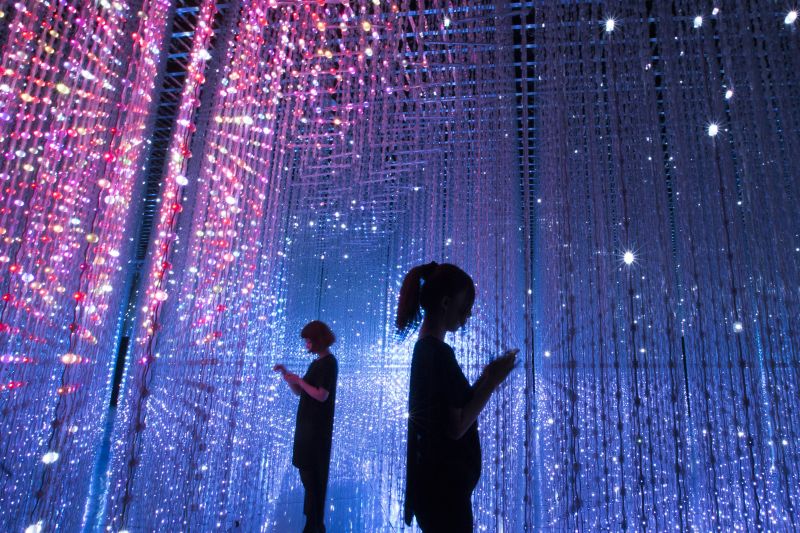When you think of a museum what do you picture? Glass display cabinets full of medieval manuscripts? Classical statues and ancient artifacts? Or perhaps stuffed animals and dinosaur skeletons.
While there will always be a place for those traditional repositories of history, there’s recently been a shift towards a different kind of museum – one that isn’t afraid to embrace change and technology.
Whether they’re leading the way with futuristic architectural designs or high-tech interactive exhibits, here are just some of the museums that are putting innovation front and center.
ArtScience Museum, Singapore
In the heart of Singapore, a lotus-inspired building intertwines art, science and technology.
The ArtScience Museum has become known for its boundary-pushing exhibits. Last year, its VR gallery transported visitors to California’s Sequoia National Park – a forest of giant sequoia trees – as part of a multi-sensory experience called “We Live in an Ocean of Air” by experimental art collective Marshmallow Laser Feast (MLF). It used 3D stereo sound, scent dispersal systems and wind machines to immerse visitors in the forest.
ArtScience Museum has also regularly collaborated with award-winning art collective teamLab to create interactive installations. The permanent exhibit “Future World: Where Art Meets Science” is a digital playground, with installations dynamically evolving as audiences pass through.
One installation, called “Crystal Universe,” is a breathtaking trip to the stars. Visitors who walk through are enveloped by over 170,000 LED lights responding to their presence.
Museum of the Future, Dubai, UAE
Museums usually document our past, but Dubai’s Museum of the Future takes the opposite approach.
A cabinet of high-tech curiosities spread across seven floors, there’s a metallic flying penguin that soars above heads, rows of suspended cylindrical capsules containing digital renderings of plant and animal species, and a library of 4,500 animal DNA codes to collect on smart devices – but that’s only the tip of the iceberg.
The museum is also home to a veritable family of robots, including a bot barista named Bob and an AI-powered humanoid robot called Ameca. This year, the latest addition is a friendly robotic dog, designed by US tech firm Boston Dynamics, which roams the lobby interacting with visitors.
Seoul Robot and AI Museum, South Korea
Many of us are uneasy about robots and artificial intelligence (AI) merging with our everyday lives, but a new museum is intended to put our minds at rest by bridging the gap in public knowledge.
The Seoul Robot and AI Museum is set to promote science, technology, and innovation in society. Robots will, of course, be exhibited throughout and the museum is also set to become a hub for smart technologies that visitors can interact with, including AI, augmented reality (AR) and virtual reality (VR).
Turkey-based Melike Altınışık Architects won a contest to design the building. Originally slated to open in 2023, it is now expected to open in late 2024.
Oman Across Ages Museum, Oman
Recently opened near the ancient city of Nizwa, the Oman Across Ages Museum uses cutting-edge technology to fly visitors through the different dynasties and civilizations that created the country.
The museum used drones to map archaeological sites, 3D-printing to produce replicas and site models, and a mix of CGI and AR to recreate ancient settlements.
Visitors can step into virtual reality to be transported inside the country’s iconic buildings, such as the Al Alam palace, one of the residences of the Sultan of Oman.
Smithsonian National Air and Space Museum, Washington D.C.
This museum maintains the world’s largest collection of historic aircraft and spacecraft with more than 68,000 objects. It also happens to be taking one giant leap to evolve its galleries and spaces for immersive learning experiences.
Last year, it launched “One World Connected,” an exhibition with a series of interactive experiences, including a 10-foot spherical projection of the globe suspended in the gallery. Using six interactive kiosks, visitors can pull up data visualizations ranging from satellite networks to animal migration routes directly onto the projection.
Beyond the Earth, visitors can feel as if they are on the surfaces of seven different planets in the “Walking on Other Worlds” exhibit, which uses a nearly 360-degree panoramic screen that combines real data and spacecraft images with CGI.
Dalí Museum, Florida
Salvador Dalí once wrote “If someday I may die, though it is unlikely, I hope the people in the cafes will say, Dali has died, though not entirely.” At the Dalí Museum, a technological resurrection has taken place, allowing visitors to interact with the Spanish surrealist using the museum’s AI reimagining of Dalí in the present day.
The project titled “Dalí Lives” is in partnership with ad agency Goodby Silverstein & Partners which used over 1,000 hours of machine learning to train an AI algorithm to learn aspects of Dali’s face, which were then projected onto an actor’s. They ended up with 125 interactive videos with thousands of different combinations, making a visitor’s experience with the reimagined Dalí just as unique as the artist himself.
Last year, the museum opened “Dream Tapestry” which used OpenAI’s AI generator DALL·E to conjure up images of visitors’ dreams with nothing but a written prompt as input. Each dream contributed to a collective tapestry displayed on a 12-foot screen.
Misalignment Museum, US
Artificial intelligence has the capacity for both good and bad and the Misalignment Museum sets out to show people its potential risks. Sprawled across a wall the text “Sorry for killing most of humanity” hovers over the museum’s pieces including an AI reimagining of Michelangelo’s “The Creation of Adam” and an army of robotic Spam cans.
The art installation hosts a tongue-in-cheek collation of work explaining aspects of AI technology from an interactive shrine called the “Church of GPT” to a never-ending discussion between AI-generated models of Werner Herzog and Slavo Žižek.
It recently finished its pop-up pilot in San Francisco, and is currently planning its next public exhibit in the city.

